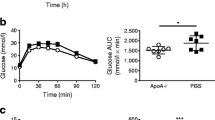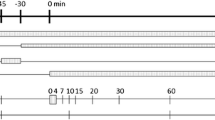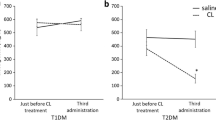Abstract
Objective
One of the major causes of diabetes and obesity is abnormality in glucose metabolism and glucose uptake in the muscle and adipose tissue based on an insufficient action of insulin. Therefore, many of the drug discovery programs are based on the concept of stimulating glucose uptake in these tissues. Improvement of glucose metabolism has been assessed based on blood parameters, but these merely reflect the systemic reaction to the drug administered. We have conducted basic studies to investigate the usefulness of glucose uptake measurement in various muscle and adipose tissues in pharmacological tests using disease-model animals.
Methods
A radiotracer for glucose, 18F-2-deoxy-2-fluoro-d-glucose (18F-FDG), was administered to Wistar fatty rats (type 2 diabetes model), DIO mouse (obese model), and the corresponding control animals, and the basal glucose uptake in the muscle and adipose (white and brown) tissues were compared using biodistribution method. Moreover, insulin and a β3 agonist (CL316,243), which are known to stimulate glucose uptake in the muscle and adipose tissues, were administered to assess their effect. 18F-FDG uptake in each tissue was measured as the radioactivity and the distribution was confirmed by autoradiography.
Results
In Wistar fatty rats, all the tissues measured showed a decrease in the basal level of glucose uptake when compared to Wistar lean rats. On the other hand, the same trend was observed only in the white adipose tissue in DIO mice, while brown adipose tissue showed increments in the basal glucose uptake in this model. Insulin administration stimulated glucose uptake in both Wistar lean and fatty rats, although the responses were inhibited in Wistar fatty rats. The same tendency was shown also in control mice, but clear increments in glucose uptake were not observed in the muscle and brown adipose tissue of DIO mice after insulin administration. β3 agonist administration showed the similar trend in Wistar lean and fatty rats as insulin, while the responses were inhibited in the adipose tissues of Wistar fatty rats.
Conclusion
A system to monitor tissue glucose uptake with 18F-FDG enabled us to detect clear differences in basal glucose uptake between disease-model animals and their corresponding controls. The responses in the tissues to insulin or β3 agonist could be identified. Taken as a whole, the biodistribution method with 18F-FDG was confirmed to be useful for pharmacological evaluation of anti-diabetic or anti-obesity drugs using disease-model animals.







Similar content being viewed by others
References
Cade WT. Diabetes-related microvascular and macrovascular diseases in the physical therapy setting. Phys Ther. 2008;88:1322–35.
Han TS, Lean ME. A clinical perspective of obesity, metabolic syndrome and cardiovascular disease. J R Soc Med Cardiovasc Dis. 2016;5:1–13.
Abranches MV, Oliveira FC, Conceição LL, Peluzio MD. Obesity and diabetes: the link between adipose tissue dysfunction and glucose homeostasis. Nutr Res Rev. 2015;28:121–32.
Zhou K, Pedersen HK, Dawed AY, Pearson ER. Pharmacogenomics in diabetes mellitus: insights into drug action and drug discovery. Nat Rev Endocrinol. 2016;12:337–46.
Rasouli N. Adipose tissue hypoxia and insulin resistance. J Investig Med. 2016;64:830–2.
Kahn B. Facilitative glucose transporters: regulatory mechanisms and dysregulation in diabetes. J Clin Invest. 1992;89:1367–74.
Katz A, Nyomba BL, Bogardus C. No accumulation of glucose in human skeletal muscle during euglycemic hyperinsulinemia. Am J Physiol (Endocrinol Metab) 1988;255:E942–945.
Ziel FH, Venkatesan N, Davidson MB. Glucose transport is rate limiting for skeletal muscle glucose metabolism in normal and STZ-induced diabetic rats. Diabetes. 1988;37:885–90.
Christen T, Sheikine Y, Rocha VZ, Hurwitz S, Goldfine AB, Di Carli M, et al. Increased glucose uptake in visceral versus subcutaneous adipose tissue revealed by PET imaging. JACC Cardiovasc Imaging. 2010;3:843–51.
Reichkendler MH, Auerbach P, Rosenkilde M, Christensen AN, Holm S, Petersen MB, et al. Exercise training favors increased insulin-stimulated glucose uptake in skeletal muscle in contrast to adipose tissue: a randomized study using FDG PET imaging. Am J Physiol Endocrinol Metab. 2013;305:E496–E506.
Reinhardt M, Beu M, Vosberg H, Herzog H, Hübinger A, Reinauer H, et al. Quantification of glucose transport and phosphorylation in human skeletal muscle using FDG PET. J Nucl Med. 1999;40:977–85.
Hansen PA, Gulve EA, Holloszy JO. Suitability of 2-deoxyglucose for in vitro measurement of glucose transport activity in skeletal muscle. J Appl Physiol. 1994;76:979–85.
Fowler JS, Wolf AP. 2-Deoxy-2-[18F]fluoro-d-glucose for metabolic studies: current status. Appl Radiat Isot. 1986;37:663–8.
Phelps ME, Huang SC, Hoffman EJ, Selin C, Sokoloff L, Kuhl DE. Tomographic measurement of local cerebral glucose metabolic rate in humans with (F-18) 2-Fluoro-2-deoxy-d-glucose: validation of method. Ann Neurol. 1979;6:371–88.
Huang SC, Williams BA, Barrio JR, Krivokapich J, Nissenson C, Hoffman EJ, et al. Measurement of glucose and 2-deoxy-2 [18F]fluoro-d-glucose transport and phosphorylation rates in myocardium using dual-tracer kinetic experiments. FEBS Lett. 1987;216:128–32.
Ishii Y, Ohta T, Sasase T. Non-obese type 2 diabetes animals models. In: Chackrewarthy S, editor. Glucose tolerance. Rijeka: InTech; 2012. pp. 223–242. doi:10.5772/52712.
Suzuki M, Odaka H, Suzuki N, Sugiyama Y, Ikeda H. Effects of combined pioglitazone and metformin on diabetes and obesity in Wistar fatty rats. Clin Exp Pharmacol Physiol. 2002;29:269–74.
Yamamoto M, Otsuki M. Effect of inhibition of alpha-glucosidase on age-related glucose intolerance and pancreatic atrophy in rats. Metabolism. 2006;55:533–40.
Ikeda H, Sugiyama Y. Insulin resistance-reducing effect of a new thiazolidinedione derivative, pioglitazone. Nihon Yakurigaku Zasshi. 2001;117:335–42.
Feng J, Zhang Z, Wallace MB, Stafford JA, Kaldor SW, Kassel DB, et al. Discovery of alogliptin: a potent, selective, bioavailable, and efficacious inhibitor of dipeptidyl peptidase IV. J Med Chem. 2007;50:2297–300.
Goto T, Nakayama R, Yamanaka M, Takata M, Takazawa T, Watanabe K, et al. Effects of DSP-8658, a novel selective peroxisome proliferator-activated receptors a/γ modulator, on adipogenesis and glucose metabolism in diabetic obese mice. Exp Clin Endocrinol Diabetes. 2015;123:492–9.
Ito M, Fukuda S, Sakata S, Morinaga H, Ohta T. Pharmacological effects of JTT-551, a novel protein tyrosine phosphatase 1B inhibitor, in diet-induced obesity mice. J Diabetes Res. 2014;2014:680348.
Lee EY, Kim YW, Oh H, Choi CS, Ahn JH, Lee BW, et al. Anti-obesity effects of KR-66195, a synthetic DPP-IV inhibitor, in diet-induced obese mice and obese-diabetic ob/ob mice. Metabolism. 2014;63:793–9.
Dimitriadis G, Mitrou P, Lambadiari V, Maratou E, Raptis SA. Insulin effects in muscle and adipose tissue. Diabetes Res Clin Pract. 2011;93:S52–9.
Kanzaki M. Insulin receptor signals regulating GLUT4 translocation and actin dynamics. Endocr J. 2006;53:267–93.
de Souza CJ, Hirshman MF, Horton ES. CL-316,243, a beta3-specific adrenoceptor agonist, enhances insulin-stimulated glucose disposal in nonobese rats. Diabetes. 1997;46:1257–63.
Park JW, Jung KH, Lee JH, Quach CH, Moon SH, Cho YS, et al. 18F-FDG PET/CT monitoring of β3 agonist-stimulated brown adipocyte recruitment in white adipose tissue. J Nucl Med. 2015;56:153–8.
Ikeda H, Shino A, Matsuo T, Iwatsuka H, Suzuoki Z. A new genetically obese-hyperglycemic rat (Wistar fatty). Diabetes. 1981;30:1045–50.
Umekawa T, Yoshida T, Sakane N, Kondo M. Effect of CL316,243, a highly specific beta(3)-adrenoceptor agonist, on lipolysis of epididymal, mesenteric and subcutaneous adipocytes in rats. Endocr J. 1997;44:181–5.
Ishino S, Miyake H, Vincent P, Mori I. Evaluation of the therapeutic efficacy of a MEK inhibitor (TAK-733) using 18F-fluorodeoxyglucose-positron emission tomography in the human lung xenograft model A549. Ann Nucl Med. 2015;29:613–20.
Säll J, Pettersson AM, Björk C, Henriksson E, Wasserstrom S, Linder W, et al. Salt-inducible kinase 2 and—3 are downregulated in adipose tissue from obese or insulin-resistant individuals: implications for insulin signalling and glucose uptake in human adipocytes. Diabetologia. 2017;60:314–23.
Henriksson E, Säll J, Gormand A, Wasserstrom S, Morrice NA, Fritzen AM, et al. SIK2 regulates CRTCs, HDAC4 and glucose uptake in adipocytes. J Cell Sci. 2015;128:472–86.
Gordon JW, Dolinsky VW, Mughal W, Gordon GR, McGavock J. Targeting skeletal muscle mitochondria to prevent type 2 diabetes in youth. Biochem Cell Biol. 2015;93:452–65.
Ferré P, Leturque A, Burnol AF, Penicaud L, Girard J. A method to quantify glucose utilization in vivo in skeletal muscle and white adipose tissue of the anaesthetized rat. Biochem J. 1985;228:103–10.
Virtanen KA, Haaparanta M, Grönroos T, Bergman J, Solin O, Rouru J, et al. 2-[(18)F]fluoro-2-deoxy-d-glucose combined with microdialysis can be used for the comparison of tissue glucose metabolism in obese and lean rats. Diabetes Obes Metab. 2002;4:60–8.
Baba S, Engles JM, Huso DL, Ishimori T, Wahl RL. Comparison of uptake of multiple clinical radiotracers into brown adipose tissue under cold-stimulated and nonstimulated conditions. J Nucl Med. 2007;48:1715–23.
Fueger BJ, Czernin J, Hildebrandt I, Tran C, Halpern BS, Stout D, et al. Impact of animal handling on the results of 18F-FDG PET studies in mice. J Nucl Med. 2006;47:999–1006.
Wong KP, Sha W, Zhang X, Huang SC. Effects of administration route, dietary condition, and blood glucose level on kinetics and uptake of 18F-FDG in mice. J Nucl Med. 2011;52:800–7.
Toyama H, Ichise M, Liow JS, Vines DC, Seneca NM, Modell KJ, et al. Evaluation of anesthesia effects on [18F]FDG uptake in mouse brain and heart using small animal PET. Nucl Med Biol. 2004;31:251–6.
Schuller E, Patel N, Item C, Greber-Platzer S, Baran H, Patsch W, et al. The genetic background modifies the effects of the obesity mutation, ‘fatty’, on apolipoprotein gene regulation in rat liver. Int J Obes Relat Metab Disord. 2000;24:460–7.
Shiota M, Printz RL. Diabetes in Zucker diabetic fatty rat. Diabetes in Zucker diabetic fatty rat. Methods Mol Biol. 2012;933:103–23.
Kooijman S, Wang Y, Parlevliet ET, Boon MR, Edelschaap D, Snaterse G, et al. Central GLP-1 receptor signaling accelerates plasma clearance of triacylglycerol and glucose by activating brown adipose tissue in mice. Diabetologia. 2015;58:2637–46.
Lee YH, Jung YS, Choi D. Recent advance in brown adipose physiology and its therapeutic potential. Exp Mol Med. 2014;46:e78.
Matsuda J, Hosoda K, Itoh H, Son C, Doi K, Hanaoka I, et al. Increased adipose expression of the uncoupling protein-3 gene by thiazolidinediones in Wistar fatty rats and in cultured adipocytes. Diabetes. 1998;47:1809–14.
Pereira LO, Lancha AH Jr. Effect of insulin and contraction up on glucose transport in skeletal muscle. Prog Biophys Mol Biol. 2004;84:1–27.
Huang S, Czech MP. The GLUT4 glucose transporter. Cell Metab. 2007;5:237–52.
Schade KN, Baranwal A, Liang C, Mirbolooki MR, Mukherjee J. Preliminary evaluation of β3-adrenoceptor agonist-induced 18F-FDG metabolic activity of brown adipose tissue in obese Zucker rat. Nucl Med Biol. 2015;42:691–4.
MacPherson RE, Castellani L, Beaudoin MS, Wright DC. Evidence for fatty acids mediating CL 316,243-induced reductions in blood glucose in mice. Am J Physiol Endocrinol Metab. 2014;307:E563–70.
Kumar A, Shiloach J, Betenbaugh MJ, Gallagher EJ. The beta-3 adrenergic agonist (CL-316,243) restores the expression of down-regulated fatty acid oxidation genes in type 2 diabetic mice. Nutr Metab. 2015;12:8.
Acknowledgements
We appreciate Mr. Yoshiteru Yamashita (Technical Services for Animal Research, Takeda Rabics. Fujisawa, Japan) doing the rat vein catheterization.
Author information
Authors and Affiliations
Corresponding author
Ethics declarations
Conflict of interest
No potential conflicts of interest were disclosed.
Rights and permissions
About this article
Cite this article
Ishino, S., Sugita, T., Kondo, Y. et al. Glucose uptake of the muscle and adipose tissues in diabetes and obesity disease models: evaluation of insulin and β3-adrenergic receptor agonist effects by 18F-FDG. Ann Nucl Med 31, 413–423 (2017). https://doi.org/10.1007/s12149-017-1169-0
Received:
Accepted:
Published:
Issue Date:
DOI: https://doi.org/10.1007/s12149-017-1169-0




